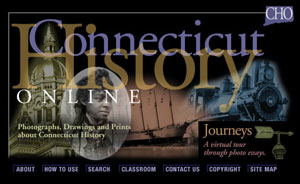talking history | syllabi | students | teachers | puzzle | about us
Connecticut History Online
http://cthistoryonline.org/index.html
Created and maintained by the Connecticut Historical Society, the Connecticut State Library, the Thomas J. Dodd Research Center at the University of Connecticut, Mystic Seaport, and the New Haven Colony Historical Society.
Reviewed Oct. 4, 2005.
Connecticut History Online (CHO) is not yet what its name suggests it is, but it is a fine resource nonetheless. CHO is currently beginning phase 2 of a two-stage development process. This review will focus on what the site currently offers, before tantalizing readers with the developers' promises of things imminent.
At this writing, Connecticut History Online provides access to almost 14,000 Connecticut related photographs, drawings, and prints generated from the beginning of the nineteenth century to the middle of the twentieth century. These imagesóranging from factory photos to family outings and all points in betweenóprovide a database of extraordinary value to educators, historians, genealogists, and history buffs. Each image is accompanied by a detailed catalog record that allows click-through access to related images by subject headings. In addition, a multilevel search engine allows searches by keyword, subject, place name, institution, date, creator, title, etc. A unique Digital Geographic Locator feature allows the inquirer to access location-specific images by clicking on a state map.
To introduce visitors to the possibilities of the database, and to provide educators models for how to employ CHO in the classroom, the developers have produced a variety of materials: 1) Journeys: image essays that explore specific themes in Connecticut history. Examples include “We Are All Connecticut Yankees: Diversity in the Early 20th Century,” "The Textile Industry in Connecticut,“ and ”Women at Work“; 2) Lesson plans and activities geared toward helping students become critical analysts of visual sources using CHO images, for example, ”Observing and Interpreting Historical Images,“ "125 Years of Childhood in Connecticut,” and “Create an Illustrated Timeline.” There are also a variety of interactive games and puzzles that, while providing nominal education in social history and perhaps geography, are just plain fun.
In its current iteration, CHO is not frustration-free. The search engine can be idiosyncratic. Searching for “Industrial Revolution,” for example, produced no hits, while “Industrial Buildings” produced 424. The “Journeys” function as short photo essays, mostly whetting the appetite for the collections rather than providing substantive content. The lesson plans, too, though useful because they emphasize visual analysis, are uneven; some may under-challenge their intended audiences. The database itself, however, remains an immensely useful resource for images of Connecticut’s last two centuries and a rich resource for teachers seeking to help students visualize an array of historic conditions.
The issues cited above will probably be rectified in the just launched second phase of the project. This will add more than 2,000 broadsides, over 550 maps, 450 images of artifacts, 40 oral histories with audio clips, 3,800 manuscripts, 200 journals and minute books, and 2,000 additional photographic images covering the period 1760 to 2000. At that point CHO will come quite a bit closer to living up to its very ambitious name.
Walter W. Woodward
University of Connecticut
Hartford, Connecticut

